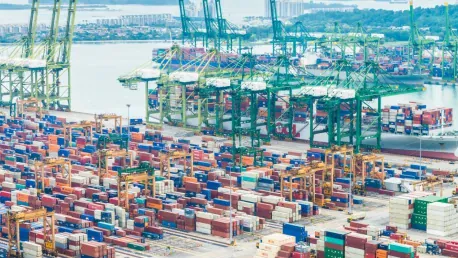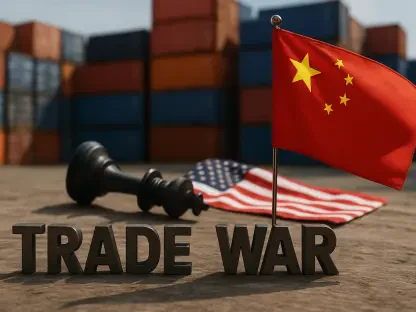The Trump administration’s recent announcement of implementing tariffs on all imported goods heralds a significant shift in U.S. trade policy. This unprecedented move is poised to have far-reaching effects on global trade dynamics and U.S. trade partnerships while stirring significant reactions in international financial markets.
Shift in U.S. Trade Policy
A New Declaration of Economic Independence
President Donald Trump made a pivotal announcement in the Rose Garden, declaring a 10 percent baseline tariff on all imported goods. This bold economic strategy aims to redefine global trade, favoring the United States and marking a “declaration of economic independence.” The policy reflects the administration’s commitment to altering the landscape of international trade. It also sets the stage for a fundamental reassessment of how the U.S. interacts with its trading partners.
This decisive move seeks to eliminate trade imbalances perceived as unfavorable to the United States. By placing a general baseline tariff on all imports, the Trump administration is effectively challenging the established norms of the global trading system. The ramifications of this decision will undoubtedly be extensive, affecting every facet of international commerce, from importers and exporters to consumers and global financial markets.
Historic Departure from Established Trade Systems
Josh Lipsky, a senior director at the GeoEconomics Center at the Atlantic Council and a former adviser to the IMF, emphasized the historic nature of this policy change. According to Lipsky, the imposition of these tariffs marks a departure from the global trading system that the U.S. helped establish. These new tariffs will elevate overall U.S. tariff rates to over 20 percent, levels not seen since the Smoot-Hawley era of the 1930s.
The shift signifies a move away from multilateral free trade agreements and towards a more protectionist stance focused primarily on balancing trade deficits. This approach redefines long-standing trade partnerships and challenges the principles that underpinned the post-World War II international trading order. The broader impact of this policy is expected to ripple through economies worldwide, prompting reassessments of trade policies by numerous other countries.
Targeting Trade Imbalances
Tariff Differentials Highlight Trade Focus
L. Daniel Mullaney, a nonresident senior fellow at the GeoEconomics Center and former assistant U.S. trade representative, explains that the varying tariff rates are designed to address specific trade imbalances, rather than to serve as a generalized protectionist barrier. For example, a higher tariff on the European Union reflects its substantial goods trade deficit with the United States, in contrast to the lower rates imposed on the United Kingdom, which has none.
These differentials highlight the administration’s targeted approach to reforming trade practices by focusing on those countries with which the United States experiences significant trade imbalances. By imposing higher tariffs on certain trading partners, the policy endeavors to create a more equitable trade environment that ostensibly benefits U.S. economic interests. This selective application of tariffs underlines the strategic calculations driving the administration’s trade policy.
Balancing Economic Considerations over Political Alliances
A striking aspect of the new tariffs is the prioritization of economic considerations over traditional political alliances or historical relationships. For instance, the tariffs imposed on Japan are notably higher than those on Iran, despite the long-standing political and military alliances between the U.S. and Japan. This decision underscores the administration’s emphasis on economic factors, as opposed to the conventional considerations of political alliances in determining tariff rates.
The rationale behind these decisions hints at a new paradigm in which economic priorities supersede geopolitical relationships. This shift could potentially lead to tensions with traditional allies, while also opening avenues for redefined economic alignments based on mutual trade interests rather than political history. The broader implications of these differentiated tariff impositions will be crucial in shaping future trade negotiations and alliances.
National Security Motives
Addressing Broader Security Concerns
Beyond economic objectives, the administration has also cited national security motives as a key justification for the new tariffs. Barbara C. Matthews, a nonresident senior fellow at the GeoEconomics Center and former U.S. Treasury attaché to the European Union, pointed out that the executive order ending tariff exemptions for low-value Chinese goods was justified on the grounds of combating the fentanyl trade. This move reflects broader security concerns linked to the international narcotics trade and its economic implications.
By addressing security issues through economic measures, the administration aims to curtail practices detrimental to U.S. interests. This dual approach underscores the multifaceted strategy of utilizing tariffs as tools for both economic and national security objectives. The focus on high-tariff rates, particularly against countries implicated in security concerns, signifies a comprehensive policy designed to leverage economic sanctions for broader national interests.
Market and Consumer Impact
The steep 54 percent tariff rate imposed on China has already led to significant market reactions, affecting the cost of a myriad of products commonly used by Americans, from electronics like AirPods to apparel. This substantial increase in consumer prices reflects broader economic ramifications, underscoring the interconnectedness of global trade practices and domestic economic well-being.
The market volatility prompted by these tariffs is indicative of the broader financial destabilization that may follow. Increased costs for consumers and businesses alike could result in reduced spending, potentially dampening economic growth. The intended corrective measures for trade imbalances, while aimed at fostering long-term economic stability for the United States, will nonetheless yield immediate challenges in the form of higher prices and market fluctuations.
Global Reaction and Strategy
Avoiding Unproductive Retaliation
In light of these dramatic shifts, countries affected by the tariffs are contemplating their responses. Mullaney advises European leaders and other global partners to avoid engaging in unproductive retaliatory measures, such as targeting politically sensitive U.S. products like Kentucky bourbon and Florida orange juice. Instead, he suggests adopting a constructive approach that aligns with the dispute mechanisms of the World Trade Organization (WTO), helping to rebalance transatlantic trade obligations through negotiation.
Such a strategy would aim to mitigate the adverse effects of the tariffs while fostering a more cooperative trade environment. By engaging in diplomatic negotiations rather than retaliations, affected countries can seek to address trade discrepancies more effectively, ensuring mutual economic benefits. This proactive, rather than reactive, stance is crucial for maintaining stability in global trade relations amidst the tumultuous changes.
Encouraging Negotiation and Collaboration
The Trump administration’s recent decision to impose tariffs on all imported goods marks a major shift in U.S. trade policy. This bold move is likely to create substantial changes in global trade dynamics and significantly impact U.S. trade relations. The implications of such a sweeping policy are vast, affecting everything from consumer prices to market stability. Countries that rely heavily on trade with the U.S. may experience economic turbulence as they adjust to new tariffs. Additionally, these tariffs could trigger retaliatory measures from other nations, potentially leading to a trade war that disrupts international financial markets. Businesses worldwide are bracing for the economic ripple effects, anticipating costs that could translate to higher prices for consumers. Investors are closely watching the situation, aware that shifts in trade policy can lead to market volatility. While supporters argue that these tariffs will protect American jobs and industries, critics warn that the broader consequences could undermine global economic stability.









